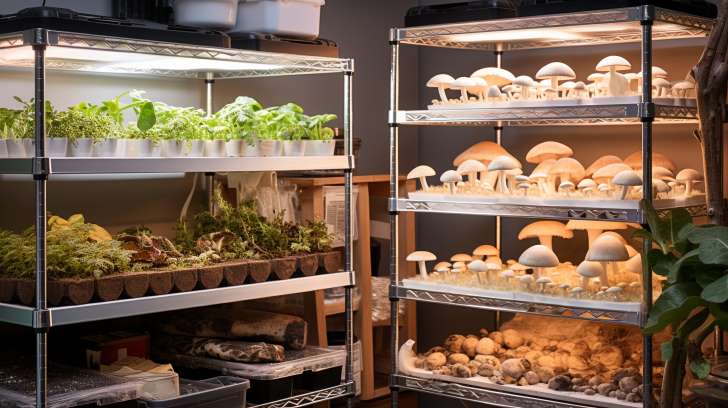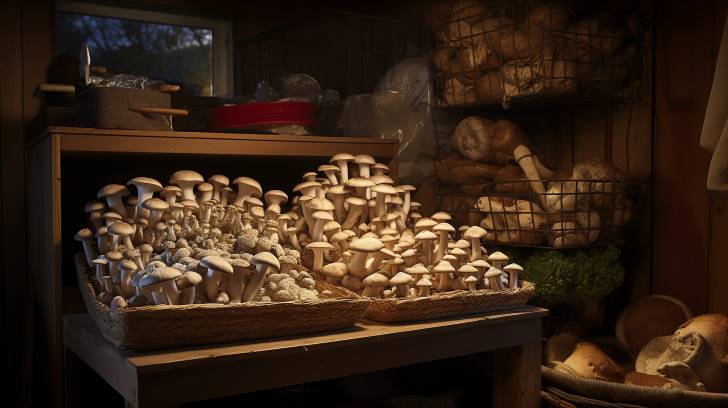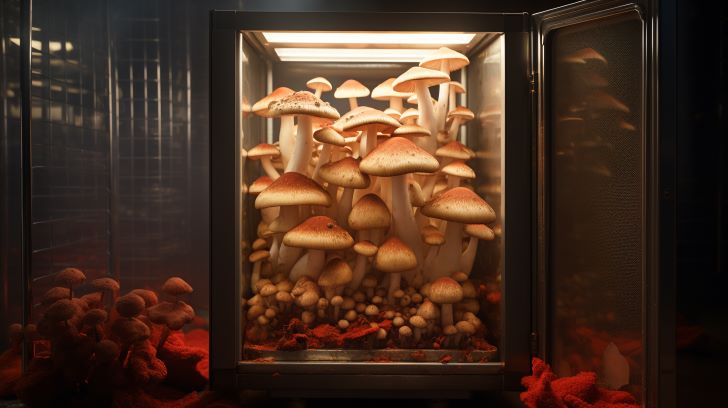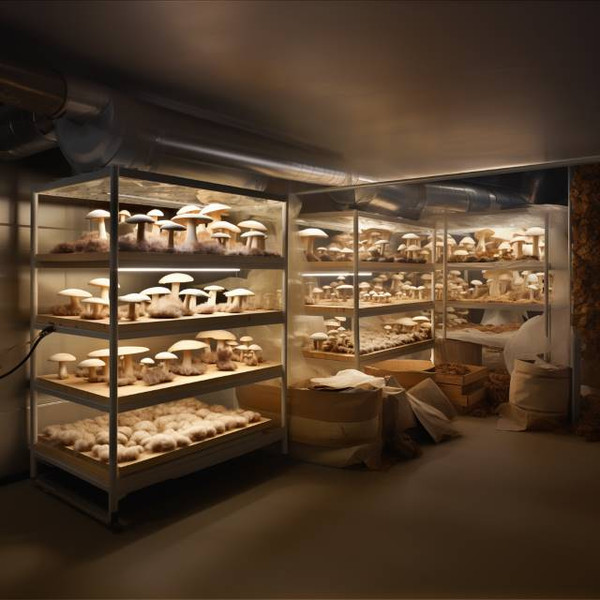How to Grow Mushrooms | Environmental Conditions, Process and Factors
Posted by Troy Cosky, Founder FunGuy Grow Supply on 18th Dec 2023

How To Grow Mushrooms: Optimal Conditions & Techniques
Imagine stepping into a world where you can cultivate your own delicious mushrooms, like a chef in a secret garden. In this guide, we'll show you how to grow mushrooms with optimal conditions and techniques. From creating the perfect environment for growth to understanding the crucial stages of the growing process, you'll learn all the essentials. Get ready to embark on a fascinating journey into the world of mushroom cultivation, where you'll be rewarded with a bountiful harvest.
Key Takeaways
- Choosing the right substrate is crucial for providing necessary nutrients for mushroom growth.
- Understanding the light requirements of different mushroom species is important for creating ideal lighting conditions.
- Monitoring and regulating temperature and humidity levels are essential for maintaining optimal environmental conditions.
- The growing process of mushrooms involves spawning, colonization, and fruiting, with each stage requiring specific attention to environmental factors.
Creating Optimal Environmental Conditions for Mushroom Growth
To create optimal environmental conditions for mushroom growth, you need to consider several factors. First, choosing the right substrate is essential, as it provides the necessary nutrients for the mushrooms to thrive. Additionally, understanding the light requirements of different mushroom species will help you create the ideal lighting conditions. Lastly, monitoring and regulating factors like temperature and humidity are crucial in maintaining the optimal environment for successful mushroom cultivation.

Creating Optimal Environmental Conditions
For optimal mushroom growth, you'll need to create the ideal environmental conditions. Here are four key factors to consider:
- Temperature: Maintain a cool environment between 55 and 65 degrees Fahrenheit for most mushrooms to thrive.
- Humidity: Keep humidity levels high, ranging from 80 to 95%, to provide the necessary moisture for successful mushroom cultivation.
- Moisture Content: Ensure the substrate's moisture content is at the correct level. Avoid excess water, as it can lead to bacterial growth and hinder mushroom production.
- Spawning: Properly prepare the substrate and introduce the mushroom spawn, which initiates the growth process.
Creating these optimal environmental conditions is crucial for the different stages of mushroom growth, from the spawning of mushrooms to their maturation. By carefully controlling temperature, humidity, moisture content, and properly introducing the mushroom spawn, you can maximize your chances of a successful mushroom harvest.
Perfect Humidity for Perfect Mushrooms
Want to see your mushrooms thrive? Check out our ultimate guide on the best mushroom humidifiers for your grow tent. It's a game-changer for mushroom lovers!
Choosing the Right Substrate for Mushroom Cultivation
Select the appropriate substrate for optimal mushroom cultivation. The choice of substrate plays a crucial role in the successful growth of mushrooms. Different types of mushrooms require different substrates. For example, oyster mushrooms thrive in straw or sawdust, while shiitake mushrooms prefer logs. It is important to consider the pH level of the substrate as well, as most mushrooms prefer a neutral pH of 7.
Once you have chosen the right substrate, you can proceed with the cultivation process. This involves inoculating the substrate with mushroom spawn or mushroom spores and providing the necessary environmental conditions for growth. Understanding the different stages of mushroom growth, such as colonization and fruiting, is essential for successful cultivation. Additionally, knowing the optimal conditions for harvesting and storage of mushrooms ensures that you can enjoy your homegrown mushrooms for a longer period of time. Now, let's move on to understanding the light requirements for mushroom growth.
Understanding Light Requirements for Mushroom Growth
To create optimal environmental conditions for mushroom growth, you need to understand the specific light requirements of the mushroom species you are cultivating. Light plays a crucial role in the fruiting process of mushrooms. Here are four important factors to consider when it comes to light requirements:
- Light intensity: Different mushrooms have varying light intensity needs. Some require bright light, while others thrive in lower light conditions.
- Duration of light exposure: The length of time mushrooms are exposed to light can impact their growth. Some mushrooms require specific daily light cycles to trigger fruiting.
- Light spectrum: Certain mushrooms respond best to specific light colors. Understanding the ideal light spectrum for your mushroom species can optimize their growth.
- Light source: Natural sunlight or artificial light sources can be used for mushroom cultivation. Choosing the right light source is crucial for providing the necessary light conditions.
Importance of Monitoring and Regulating Environmental Factors for Mushroom Cultivation
To ensure successful mushroom growth, it is essential to monitor and regulate environmental factors by using specialized equipment and techniques. Commercial growers understand the importance of creating optimal environmental conditions for mushroom cultivation, as it directly affects the growth and quality of the crop. By carefully controlling factors such as temperature, humidity, and lighting, growers can create an environment that is conducive to mushroom growth.
| Environmental Factors | Importance | Techniques |
|---|---|---|
| Temperature | Proper temperature is crucial for mushroom growth. It affects the rate of mycelium growth and fruiting. Maintaining a consistent temperature within the optimal range is essential. | Use of temperature-controlled grow rooms or climate control systems. |
| Humidity | Adequate humidity levels promote mycelium growth and prevent drying out of the substrate. It also helps in preventing contamination. | Use of humidifiers, misters, or maintaining a humid environment using polyethylene sheets. |
| Lighting | While mushrooms do not require direct light for growth, they do need some light to trigger the fruiting process. Light also helps in proper development and growth of the mushrooms. | Use of low-intensity artificial light sources or natural light from windows. |
The Growing Process: Spawning, Colonization, and Fruiting
To successfully grow mushrooms, it is important to understand the three main stages of the growing process: spawning, colonization, and fruiting. These stages are crucial for cultivating a bountiful and thriving crop.

Here are the key points to keep in mind:
- Spawning: This is the initial stage where mushroom spawn, a combination of mycelium and substrate, is mixed into a larger batch of substrate. The spawn acts as the foundation for mushroom growth.
- Colonization: During this stage, the mycelium grows and spreads throughout the substrate. The mycelium matures and develops in a process known as colonization. It is essential to ensure the substrate is completely colonized before moving on to the next stage.
- Fruiting: Once the substrate is fully colonized, the fruiting process begins. The mycelium forms a 'pinhead' that eventually develops into the recognizable cap, stem, and gills of a mushroom. This is the stage where the mushrooms fully mature and become ready for harvest.
- Environmental Factors: Throughout the growing process, environmental conditions such as temperature, humidity, and lighting play a vital role. Different types of mushrooms require specific conditions for optimal growth. It is important to monitor and regulate these factors to create the ideal environment for each mushroom species.
Understanding the spawning, colonization, and fruiting stages is essential for successful mushroom cultivation. By carefully managing the environmental conditions and providing the necessary resources, you can ensure a fruitful harvest of delicious mushrooms.
Factors Affecting Mushroom Growth: Contamination, Nutrient Availability, and Airflow
Now let's talk about the factors that can affect the growth of your mushrooms. Contamination is a major concern, as it can hinder their development and even ruin your entire crop. Nutrient availability is also crucial, as mushrooms require specific nutrients to thrive. Lastly, proper airflow is important to maintain a healthy growing environment and prevent the accumulation of harmful gases.

Contamination
Ensure proper sterilization measures to prevent contamination and promote optimal mushroom growth. Contamination can be a major obstacle in mushroom cultivation, but with the right precautions, you can minimize its impact. Here are some key factors to consider:
- Cleanliness: Maintaining a clean environment is crucial to prevent the introduction of contaminants.
- Sterilization: Properly sterilize your substrate and equipment to eliminate any potential sources of contamination.
- Hygiene: Practice good hygiene by washing your hands thoroughly and using sterile gloves when handling the substrate or mushrooms.
- Isolation: Keep your mushroom cultivation area separate from other areas to avoid cross-contamination.
Nutrient Availability
Maintain proper nutrient availability to optimize mushroom growth and continue promoting a contamination-free environment. Different varieties of mushrooms require specific substrates for their growth. It is crucial to provide the right substrate enriched with essential nutrients such as nitrogen, carbon, and trace elements. These nutrients create a nurturing environment for the mycelium, allowing it to thrive and produce abundant fruiting bodies. Ensuring nutrient availability is essential for maximizing mushroom growth and yield. Carefully selecting and preparing the substrate with the necessary nutrients will contribute to the overall success of your mushroom cultivation process. Regularly monitoring and adjusting nutrient levels as needed will help create the ideal conditions for your mushrooms to flourish. By prioritizing nutrient availability, you can create the optimal environment for robust mushroom growth while minimizing the risk of contamination.
Airflow
To optimize mushroom growth and minimize the risk of contamination, it is important to ensure adequate airflow throughout the growing environment. Here are four factors that highlight the importance of airflow:
- Regulates temperature and humidity levels
- Prevents the buildup of harmful gases
- Ensures proper exchange of gases
- Reduces the risk of contamination
Proper airflow helps regulate the temperature and humidity, preventing the environment from becoming too hot or too damp. It also prevents the accumulation of harmful gases, such as carbon dioxide, which can inhibit mushroom growth. Furthermore, adequate airflow ensures the proper exchange of gases, allowing mushrooms to receive the necessary oxygen for healthy development. Lastly, good airflow reduces the risk of contamination by minimizing stagnant air and providing fresh air circulation. Now, let's move on to the next section where we will discuss the importance of temperature, humidity, and lighting in mushroom growth.
Temperature, Humidity, and Lighting
To optimize mushroom growth and minimize the risk of contamination, you need to carefully control the temperature, humidity, and lighting conditions. Temperature plays a crucial role in the growth of mushrooms. Most mushrooms thrive in temperatures between 55 and 65 degrees Fahrenheit. Maintaining the ideal temperature range ensures proper mycelial growth and timing of the fruiting process. Humidity is equally important for successful fruiting. Elevated humidity levels are essential to stimulate the fruiting process. Mushrooms require a humid environment to develop and mature. Additionally, lighting can act as a catalyst in the fruiting process. Providing the right amount of light can help initiate and promote the growth of mushrooms. It is important to balance these factors to create optimal conditions for mushroom cultivation.
Harvesting and Storage of Mushrooms
To ensure optimal quality and increased crop yield, you must harvest mushrooms at the right time. Determining the right time to harvest is crucial for achieving high-quality yields.

Here are some important points to keep in mind when it comes to harvesting and storing mushrooms:
- Harvest when fully mature: The fruiting body should be harvested when it is fully mature and just before the cap begins to open. Gently press the cap to check for firmness.
- Gentle harvesting technique: When harvesting, gently twist and pull the stem at the base of the mushroom to avoid damaging the mycelium and substrate. This will ensure future growth.
- Proper storage conditions: Mushrooms are highly perishable, so it's important to store them correctly. Keep them in a dark and cool location, preferably in the refrigerator. This will help maintain their freshness and quality.
- Consider proper packaging: To promote airflow and prevent dampness, consider placing mushrooms in a paper bag or wrapping them with a paper towel. This will help maintain their texture and prevent spoilage.
Conclusion: Understanding and Managing Environmental Conditions
To effectively grow mushrooms, it is crucial to understand and manage the environmental conditions they require. Mushrooms are highly sensitive organisms that thrive in specific conditions. One important factor to consider is the nutrient composition of the growing medium. Mushrooms obtain their nutrients by breaking down organic matter, so the substrate should be rich in materials such as straw, wood chips, or compost. Additionally, maintaining the right humidity level is essential for successful mushroom cultivation. Most species require a humidity range of 80-90%, which can be achieved by misting the growing area regularly or using a humidifier.

Temperature is another critical factor in mushroom growth. Different species have specific temperature requirements, but as a general guideline, most mushrooms prefer temperatures between 55-70°F (13-21°C). It is important to monitor and control temperature fluctuations, as extreme variations can hinder growth or even lead to the development of molds or other contaminants.
Light is not as crucial for mushroom growth as it is for plants, but it still plays a role in the process. Mushrooms do not require direct sunlight, but they do need some light exposure to trigger the fruiting process. Indirect light or low-intensity artificial light sources can be used to provide the necessary light stimulation.
Optimize Your Mushroom Harvest
Ready to take your mushroom cultivation to the next level? Discover the secrets of moisture and fresh air exchange with FunGuy Mushroom Supply's premium products. From colonization to fruiting, we've got your needs covered. Shop now for a flourishing mushroom harvest!
Frequently Asked Questions
How Long Does It Take for Mushrooms to Fully Colonize a Substrate?
It usually takes a few weeks for mushrooms to fully colonize a substrate. During this time, the mycelium (the network of fungal threads) gradually spreads and consumes the organic material. The exact duration can vary depending on factors such as the type of mushroom, the temperature, and the moisture levels. It's important to monitor the progress and make any necessary adjustments to ensure optimal conditions for the mushrooms to thrive.
Can I Use a Different Type of Substrate for Growing Mushrooms?
Can you use a different type of substrate for growing mushrooms? Absolutely! The type of substrate you choose can have a significant impact on the growth and development of your mushrooms. Different substrates provide varying levels of nutrients and moisture, which can affect the flavor, texture, and overall quality of your mushrooms. So, feel free to experiment with different substrates and find the perfect one for your mushroom growing endeavors. Happy growing!
What Are the Common Signs of Contamination in Mushroom Cultivation?
When cultivating mushrooms, it's important to be aware of common signs of contamination. These signs can include the growth of mold or bacteria on the substrate, unusual colors or textures on the mushrooms, and foul odors. Contamination can significantly affect the health and yield of your mushroom crop, so it's crucial to keep a close eye on any unusual developments. Regularly inspecting your growing environment and maintaining proper hygiene practices can help prevent contamination issues.
Is It Possible to Store Harvested Mushrooms for an Extended Period of Time?
Yes, you can store harvested mushrooms for an extended period of time. Proper storage techniques are essential to maintain their freshness and quality. Make sure to clean the mushrooms thoroughly and remove any dirt or debris. Store them in a paper bag or airtight container, preferably in the refrigerator. Avoid washing them until you are ready to use them to prevent moisture buildup. With proper storage, you can enjoy your harvested mushrooms for weeks or even months.
Are There Any Specific Techniques to Ensure Optimal Airflow in a Mushroom Growing Environment?
When it comes to creating the perfect environment for your mushroom growth, ensuring optimal airflow is key. You want those little fungi to feel like they're strolling through a gentle breeze on a warm summer day. Good airflow helps prevent the buildup of excess moisture, which can lead to mold and other unwanted guests. So, make sure to set up proper ventilation systems and keep those air currents flowing smoothly for your mushrooms to thrive.
References
- Jain, P., & Pundir, R.K. (2019). Biocontrol of Soil Phytopathogens by Arbuscular Mycorrhiza – A Review. Mycorrhizosphere and Pedogenesis.
- Sanchez-Lizarraga, A.L., Dendooven, L., Marino-Marmolejo, E.N., Davila-Vazquez, G., Hernández-Cuevas, L.V., Arenas-Montaño, V., & Contreras-Ramos, S.M. (2017). Presence and diversity of arbuscular mycorrhizal fungi in soil regularly irrigated with vinasses. Journal of Soil Science and Plant Nutrition, 17, 1116-1129. https://www.semanticscholar.org
- Weng, W., Yan, J., Zhou, M., Yao, X., Gao, A., Ma, C., Cheng, J., & Ruan, J. (2022). Roles of Arbuscular mycorrhizal Fungi as a Biocontrol Agent in the Control of Plant Diseases. Microorganisms, 10(7), 1266. https://doi.org/10.3390/microorganisms10071266
- Rajtor, M., & Piotrowska-Seget, Z. (2016). Prospects for arbuscular mycorrhizal fungi (AMF) to assist in phytoremediation of soil hydrocarbon contaminants. Chemosphere, 162, 105–116. https://doi.org/10.1016/j.chemosphere.2016.07.071

